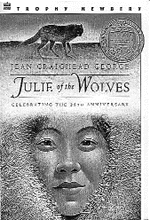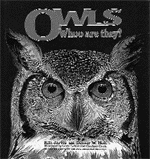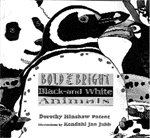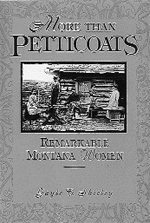FALL 1998
Volume 16, Number 1
![]()

Julie of the Wolves
by Jean Craighead George. Illustrated by John Schoenherr.
New York: Harper Trophy, 1972. 170 pp. $4.95.
Miyax, the protagonist of Jean Craighead George’s Newbery Medal-winning novel Julie of the Wolves, is an irresistible heroine. Resourceful, independent, self-reliant and intelligent, the thirteen-year-old Eskimo girl escapes from a fourteen-year-old husband and unloving in-laws across the Arctic tundra to become part of a wolf pack, at first for survival and then for comfort and friendship. The story is a gripping, well-paced and honest account of Arctic survival, and the descriptions of animal behavior educate along the way.
The wolves, rendered in sparkling detail by the author, have vivid personalities. Miyax makes herself part of their family, first by learning their code of ears, tails, yips and growls. She practices the rules of survival that have been honed and handed down by her ancestors, and best of all, she is fearless-even when faced with the loneliness of the tundra.
George wrote the book nearly three decades ago, but it is a timeless tale about coming of age and inner strength that will excite childhood readers, wrapping them in the blissful oblivion of good fiction.

| Owls: Whoo are they? by Kila Jarvis and Denver W. Holt. Illustrated by Leslie Leroux and Courtney Couch. Missoula ,Montana: Mountain Press Publishing Company, 1996. 60 pp. $12 paperback. |
Handsome and utterly delightful, Owls makes the world of this bird clear and simple. The text is printed in large, bold type and has a straightforward brightness to it. The illustrations nearly swoop from the page in their spry evocation of owls. Short sections focus on subjects such as the owl’s tufts, ears, mating habits, rearing of young and hunting techniques. Descriptions are clear and spiced with fun questions. As the reader learns, for example, how an owl hears, she is invited to consider her own ears.
Owls is the rare science book that is as lively as a good story because the authors and illustrators, working in perfect collaboration, make a good story out of owls-by turns funny, educational and just plain cool. The pages of text are illuminated by Ed Jenne’s whimsical “owlphabet,” and the book’s oversized format makes it a pleasure to hold and spread open-its large pages are filled with startling, vivid owl eyes. The language of the book is respectful towards its youngest readers and lively enough to keep parents interested.

| Bold and Bright, Black-and-White Animals by Dorothy Hinshaw Patent. Illustrated by Kendahl Jan Jubb. New York: Walker and Company, 1998. 32 pp. $15.95 hardcover. |
In her 100th book for children, Dorothy Hinshaw Patent explores zebras, penguins, skunks, pandas, pelicans and ruffed lemurs, as well as other mammals, fish and reptiles-all united by their high-contrast coloring. Each double page contains a brief, simple description of the animal and an explanation of its markings. Zebras, for example, dizzy their predators as a giant mass of stripes. As they hunt, penguins are obscured in the water because their white bellies blend with the light sky above, and fish can’t see them.
Kendahl Jan Jubb’s illustrations throb with color around the black-and-white subjects. The skunk slithers in a mass of tulips, and the striped sea snake wriggles amidst glowing fish. She paints her creatures close up, filling the page with giant eyes and paws. And to the delight of any child, Jubb has tucked other animals into the periphery. They peek out from leaves and trees, waiting to be discovered.

| More Than Petticoats: Remarkable Montana Women by Gayle C. Shirley. Helena, Montana: Falcon Publishing Inc., 1995. 142 pp. $8.95. |
The first woman to practice law in Montana was Ella Knowles Haskell. She earned her debut client by collecting his “bad debts”: two umbrellas that had been borrowed and never returned. Haskell wrote, in what would become a common refrain for all working women, that the businessmen of the day “did not receive me well. They didn’t take kindly to the idea of a woman ‘doing a man’s work.”’
Gayle C. Shirley’s slim and readable collection More Than Petticoats: Remarkable
Montana Women is filled with stories of women who pioneered not just the unforgiving terrain of Montana in the nineteenth century but forged new roles-besides daughter, wife and mother-for themselves. Many of these stories are remarkable for what the women accomplished, in spite of marital or family obligations or suspicious societies around them.
There is the woman who brought an organized school system to the territories, the nun with a life’s dream of working among the Indians, the former slave girl turned wealthy landowner and the notable artists, doctors and politicians. Photographer Evelyn Cameron and peace activist Jeannette Rankin are perhaps the best known of Shirley’s subjects, but she has gathered a fascinating and diverse collection of women here for the junior reader. She also has conveyed a sense that these women mattered not just to their time, but to all time.
Clearly and crisply told, the chapters are wonderful to read aloud-they are adventure stories, one woman at a time, complete with the muslin-lined log cabins, dead babies, failing health and diptheria that defined the hard, new life on the plains and in the mountains. While illuminating these antique portraits, Shirley also is careful to sketch the commonalities between these historic lives and the lives of modern children-the ballgames, dolls, tricks and heart-fluttering crushes-so that even as she writes of homesteading and raising buffalo, her subjects are accessible.
| TIPS FOR CHOOSING CHILDREN'S BOOKS
Choosing a good book for your child can be daunting, but Carolyn Lott, UM associate professor of education, offers six basic qualifications that may help. Here’s what to look for: Literary quality-Books should have good plots, strong characters and exciting conflicts. Quality of art-Look for the art and the text to complement, supplement and support one another. Age appropriateness-The material should be a little ahead-in reading and social development-of the child so that it is relevant yet challenging. Relevance-The book should meet the needs and interests of the child. For example, a book pertaining to getting a new sibling or starting school would be great for children in those situations. Balance and variety-A child’s library should reflect balance among genres, subjects, authors and cultures and offer a variety that is constantly interesting to the reading palate. While it’s great for a child to investigate all the works of Roald Dahl’s work if she likes one book, it is also important that she “balances her diet” to keep her mind flexible. Reader participation-Any children’s book should encourage active reading-by eliciting a response from the reader. Books should be shelved together, without distinction, so that children can choose what they like. Use any book to discuss literary devices, such as foreshadowing, point of view or dialect. |